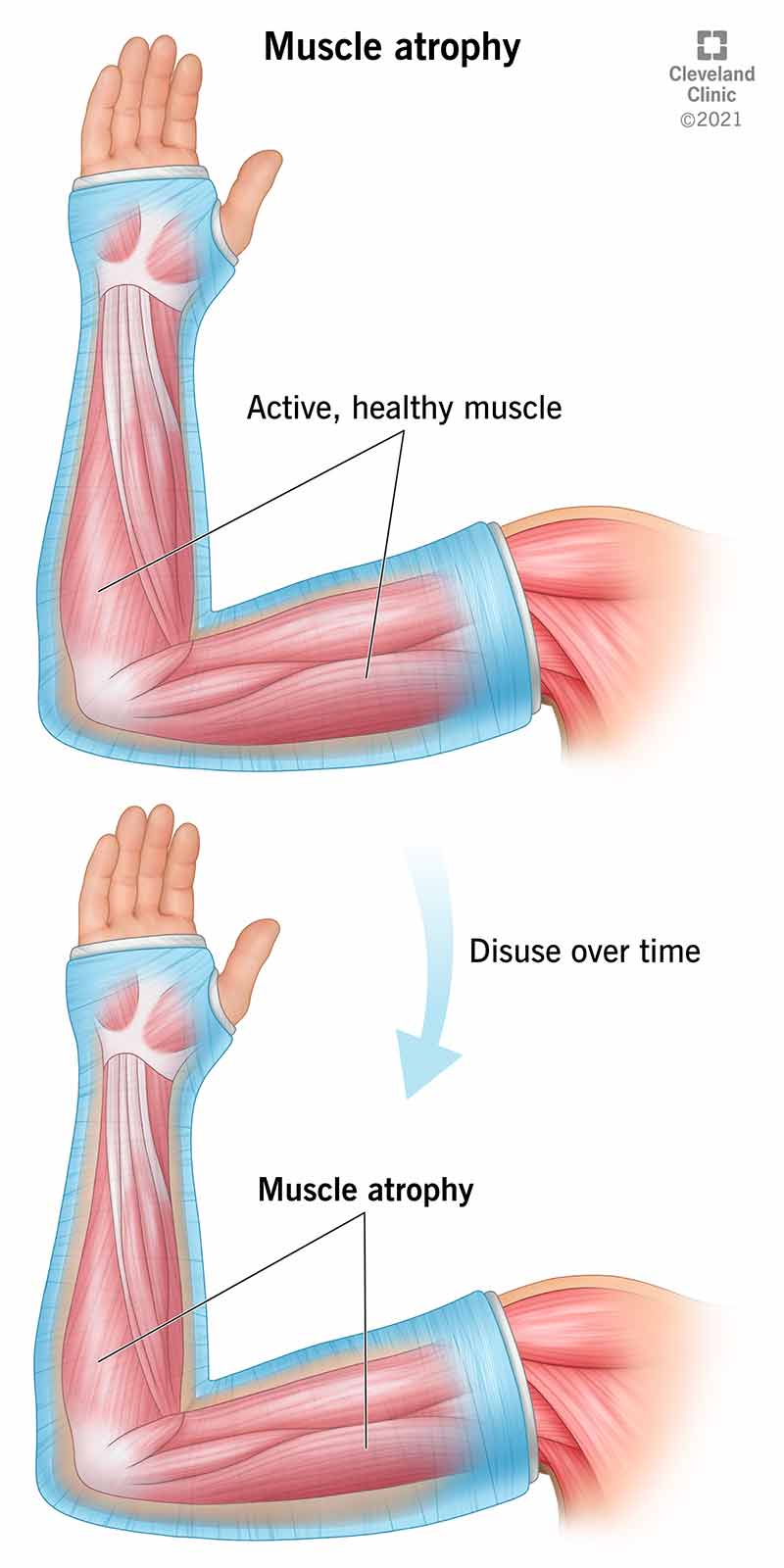Muscle atrophy is the wasting or thinning of muscle mass. It can be caused by disuse of your muscles or neurogenic conditions. Symptoms include a decrease in muscle mass, one limb being smaller than the other, and numbness, weakness and tingling in your limbs. Disuse atrophy can be reversed with exercise and a healthy diet.
Advertisement
Cleveland Clinic is a non-profit academic medical center. Advertising on our site helps support our mission. We do not endorse non-Cleveland Clinic products or services. Policy

Muscle atrophy is the loss or thinning of your muscle tissue. If you have atrophied muscles, you’ll see a decrease in your muscle mass and strength. With muscle atrophy, your muscles look smaller than normal. Muscle atrophy can occur due to malnutrition, age, genetics, a lack of physical activity or certain medical conditions. Disuse (physiologic) atrophy occurs when you don’t use your muscles enough. Neurogenic atrophy occurs due to nerve problems or diseases.
Advertisement
Cleveland Clinic is a non-profit academic medical center. Advertising on our site helps support our mission. We do not endorse non-Cleveland Clinic products or services. Policy
The symptoms of muscle atrophy differ depending on the cause of your condition. The most obvious sign of muscle atrophy is reduced muscle mass. Other signs of muscle atrophy may include:
If you have muscle atrophy in your limbs, you may feel tingling, numbness or weakness in your arms and legs. If you have atrophied muscles in your face or throat, your facial muscles may start feeling weak and you may find it difficult to speak or swallow.
The cause of muscle atrophy depends on the type you have. Disuse (physiologic) atrophy is caused by not using your muscles enough. If you stop using your muscles, your body won’t waste the energy it needs to take care of them. Instead, your body will start to break your muscles down, which causes them to decrease in size and strength. Disuse atrophy may affect you if you:
Advertisement
Neurogenic atrophy is caused by an injury or disease affecting nerves that connect to your muscles. When these nerves are damaged, they can’t trigger the muscle contractions that are needed to stimulate muscle activity. When your muscles don’t contract, your body thinks you don’t need them anymore. So your body starts breaking them down, which causes them to decrease in size and strength. Diseases and other conditions that can affect these nerves include:
The amount of time it takes for your muscles to atrophy depends on your age, fitness level and cause of atrophy. If your muscle atrophy is due to disuse (physiologic), the process can start within two to three weeks of not using your muscles. Neurogenic muscle atrophy may develop sooner depending on your health condition.
To diagnose muscle atrophy, your healthcare provider will give you a physical exam and ask you about your symptoms. They’ll look at your arms and legs and measure your muscle mass. In addition, your healthcare provider may order tests, including:
Disuse (physiologic) atrophy can sometimes be reversed with exercise and a healthy diet. Your healthcare provider may start you on a program that includes exercises in the pool. Working out in the water can reduce your muscle workload. Neurogenic atrophy typically can't be reversed because of the physical damage that’s been done to your nerves.
Treatment for muscle atrophy depends on the type. Disuse (physiologic) atrophy can be treated with regular exercise and better nutrition. Your healthcare provider may recommend physical therapy or an exercise plan. Even if you can’t actively move certain joints in your body, you can do still exercises wearing a splint or brace. Your healthcare provider may have you work with a dietitian on a healthy eating plan. They may suggest nutritional supplements as well.
Neurogenic atrophy can sometimes be treated with a special kind of physical therapy called electrical stimulation. Your physical therapist will place electrodes on your skin over your muscles. The electrodes send small electrical impulses to your nerves and muscles. The electrical impulses try to artificially exercise or contract your muscles. This can help you maintain your muscle mass and strength.
Advertisement
Your physical therapist may also recommend ultrasound therapy. Ultrasound therapy uses sound waves to promote muscle healing.
If you develop a contracture due to your muscle atrophy, your healthcare provider may perform surgery to correct it. A contracture occurs when your muscle tissues become fibrous. This tissue makes it hard for you to stretch the muscle and prevents movement.
The amount of time it takes to regain muscle after atrophy depends on the type of atrophy and how severe your condition was. Disuse (physiologic) atrophy is usually reversible, but it won’t happen overnight. You can recover from muscle atrophy by exercising regularly and eating a healthy diet. You may start seeing improvement after a few months, but it may take much longer for you to fully recover your strength.
Muscle atrophy is a loss of muscle mass. Muscle hypertrophy is an increase of your muscle mass. Your muscle fibers get bigger or thicken. Muscle hypertrophy occurs due to an increase in the volume of your muscle cells. You may experience muscle hypertrophy through workout routines such as strength training or high-intensity interval training (HIIT).
If you notice certain parts of your body look smaller or feel weaker, reach out to your healthcare provider. While a diagnosis of muscle atrophy isn’t easy, it’s important to remember that disuse (physiologic) atrophy can be reversed. Your healthcare provider can recommend a plan that’ll work for you. It can be hard to stay motivated, but stick with the plan. You’ll need it to help rebuild your muscle mass and strength.
Advertisement
Cleveland Clinic’s primary care providers offer lifelong medical care. From sinus infections and high blood pressure to preventive screening, we’re here for you.

Last reviewed on 01/21/2022.
Learn more about the Health Library and our editorial process.